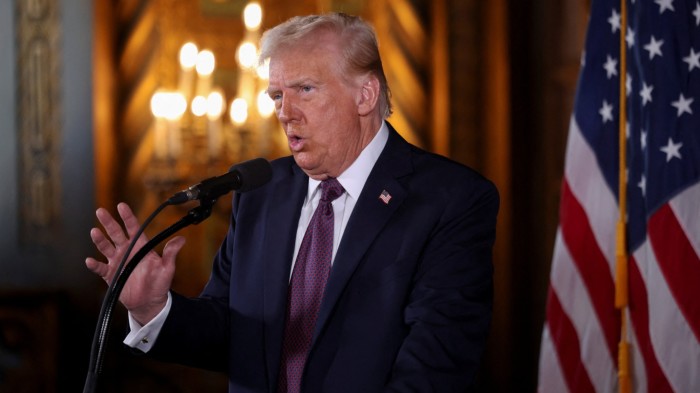Donald Trump has refused to rule out the use of force to take Greenland or take control of the Panama Canal as he vowed to rename the Gulf of Mexico the “Gulf of America”.
In a press conference less than two weeks before taking office, the US president-elect threatened to use his country’s economic and military power against traditional allies to further national security and territorial expansion.
Asked if he would rule out using military or economic coercion to take Greenland or take control of the Panama Canal, he said: “No, I can’t assure you of either of those two. But I can say this, we need them for economic security. . . We need Greenland for reasons of national security.”
At Tuesday’s press conference at his Mar-a-Lago estate in Florida, Trump vowed to “tariff Denmark at a very high level” if the country did not relinquish control of Greenland, which he had demanded bought during his first term.
Earlier on Tuesday, Danish Prime Minister Mette Frederiksen said Greenland, which is an autonomous part of the kingdom of Denmark, was “not for sale”, but stressed that she was keen to cooperate with Washington in the Arctic.
Responding to Trump’s recent comments, she added that the US was Denmark’s “most important and closest ally” and that she did not have the “imagination to believe that we would reach” a possible military crackdown. or economic to gain control of Greenland.
Trump has since 2019 sought control of the world’s largest island, which is home to just 56,000 people but central to the strategically vital Arctic region.
He also argued in his press conference that the US needed control of the Panama Canal, which the country built more than 100 years ago, because of the canal’s strategic role.
“The Panama Canal is vital to our country,” he said. “It is being operated from China. . . And we gave Panama the Panama Canal, we didn’t give it to China.”
In a broader take on a traditional ally, Trump said a US annexation of Canada “would really be something” but would happen through “economic force” rather than military action.
“You get rid of that artificially drawn line and take a look at what it looks like, and it would also be much better for national security. Remember, we primarily protect Canada,” he said.
Citing US deficits with both countries and an influx of immigrants across the southern US border, Trump said he was prepared to hit Canada and Mexico with higher taxes. “We will impose very serious tariffs on Mexico and Canada. . . then we want to get along with everybody,” he said.
“We will change the name of the Gulf of Mexico to the Gulf of America,” he added. “What a beautiful name. And it’s convenient.”
Trump labeled Mexico a “very dangerous country” that was “allowing millions of people to pour into our country” and was “basically run by drug cartels.”
Mexico has experienced an unprecedented wave of killings since 2009 with organized crime groups expanding their reach from drug and migrant trafficking to oil theft and extortion.
When Trump first suggested imposing tariffs on Mexico and Canada shortly after his election in November, Mexican President Claudia Sheinbaum initially hinted at retaliatory measures.
While the two leaders said they had a cordial conversation afterward, Sheinbaum is now bracing for an onslaught of mass deportations, trade barriers and pressure for greater U.S. involvement in dealing with the cartels.
Additional reporting by Richard Milne


